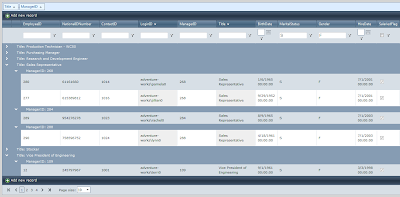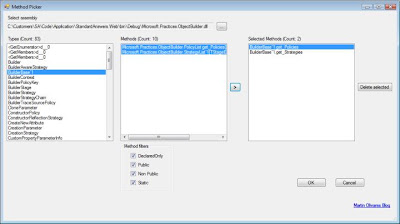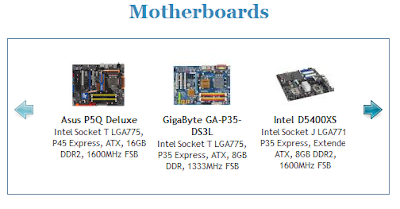Saturday, June 20, 2015
Kendo Grid State Manager Plugin
This is my first GitHub project and could be found at: https://github.com/martinolivares/kendo-gridstatemanager-plugin
Below a preview:
Hope you find it useful ;)
Friday, June 22, 2012
Realtime data editing using an Excel-like grid and KnockoutJs
- Send changes without need confirmation
- Quickly Navigate to any field that you want edit
- Provide a visual indicator of the updated fields
- Updates are sent back to the server when textboxes lost focus: using a KnockoutJs extender the temperature fields changes are captured and sent to server using ajax calls.
- Updated values are highlighted: a css binding changes the textbox background color after a field is updated successfully on server
- Key based navigation: a jQuery handler allow navigate between textboxes using the arrows keys
ko.extenders.realtime = function(target, options) { // store private vars to use as parameters on updates // cityId: the key of entity to be updated // daytime: the field of entity to be updated (Morning/Afternoon/Midnight) target.cityId = options[0]; target.daytime = options[1]; //add a sub-observable to mantain a changed flag target.hasChanged = ko.observable(false); //define a function to send updates function update(newValue) { $.ajax({ url: "/home/updateforecast", data: { cityId: target.cityId, daytime: target.daytime, value: newValue }, type: "post", success: function(result) { if(result) target.hasChanged(true); } }); } //update whenever the value changes target.subscribe(update); //return the original value return target; };
var model = @Html.Raw(new JavaScriptSerializer().Serialize(Model)); var viewModel = { forecasts : ko.observableArray(ko.utils.arrayMap(model, function(forecast) { return new ForecastModel(forecast); })) }; function ForecastModel(forecast) { this.City = ko.observable(forecast.City); // extend the observable fields that will be updated in realtime this.Morning = ko.observable(forecast.Morning).extend({realtime:[forecast.Id, "Morning"]}); this.Afternoon = ko.observable(forecast.Afternoon).extend({realtime:[forecast.Id, "Afternoon"]}); this.Midnight = ko.observable(forecast.Midnight).extend({realtime:[forecast.Id, "Midnight"]}); } ko.applyBindings(viewModel);
<h1> Realtime Weather Forecast Editor</h1> <table id="tblForecasts"> <thead> <tr> <th> City </th> <th> Morning </th> <th> Afternoon </th> <th> Midnight </th> </tr> </thead> <tbody data-bind="template: { name: 'forecastRowTemplate', foreach: forecasts }"> </tbody> </table> <script type="text/html" id="forecastRowTemplate"> <tr> <td><span data-bind="text: City"/></td> <td><input data-bind="value: Morning, css: { hasChanged: Morning.hasChanged }"/></td> <td><input data-bind="value: Afternoon, css: { hasChanged: Afternoon.hasChanged }"/></td> <td><input data-bind="value: Midnight, css: { hasChanged: Midnight.hasChanged }"/></td> </tr> </script>
$("#tblForecasts").on("keydown", "input:text", function(e) { // detect arrows pressing if (e.keyCode < 37 || e.keyCode > 40) return; e.preventDefault(); var target; var cellAndRow = $(this).parents('td,tr'); var cellIndex = cellAndRow[0].cellIndex; var rowIndex = cellAndRow[1].rowIndex; switch (e.keyCode) { // left arrow case 37: cellIndex = cellIndex - 1; break; // right arrow case 39: cellIndex = cellIndex + 1; break; // up arrow case 40: rowIndex = rowIndex + 1; break; // down arrow case 38: rowIndex = rowIndex - 1; break; } target = $('table tr').eq(rowIndex).find('td').eq(cellIndex).find("input:text"); if (target != undefined) { target.focus(); target.select(); } });
public class Forecast { public int Id { get; set; } public string City { get; set; } public int Morning { get; set; } public int Afternoon { get; set; } public int Midnight { get; set; } }
private const string C_ForecastModels = "ForecastModels"; // Expose the stored Forecasts from Session public IEnumerable<Forecast> ForecastModels { get { if (Session[C_ForecastModels] == null) { Session[C_ForecastModels] = new[] { new Forecast { Id=1, City="Barcelona", Morning=90, Afternoon=45, Midnight=40}, new Forecast { Id=2, City="Berlin", Morning=78, Afternoon=34, Midnight=0 }, new Forecast { Id=3, City="New York", Morning=45, Afternoon=35, Midnight=20 }, new Forecast { Id=4, City="Sydney", Morning=65, Afternoon=45, Midnight=40 }, new Forecast { Id=5, City="Tokio", Morning=74, Afternoon=70, Midnight=60 } }; } return Session[C_ForecastModels] as IEnumerable<Forecast>; } set { Session[C_ForecastModels] = value; } } public ActionResult Index() { // Return the Session stored Forecasts return View(ForecastModels); } // // Update Forecast value for selected daytime (Morning/Afternoon/Midnight) [HttpPost] public JsonResult Updateforecast(int cityId, string daytime, int value) { var cityForecast = ForecastModels.SingleOrDefault(forecastModel => forecastModel.Id == cityId); if (cityForecast == null) return Json(false); switch (daytime) { case "Morning": cityForecast.Morning = value; break; case "Afternoon": cityForecast.Afternoon = value; break; case "Midnight": cityForecast.Midnight = value; break; } return Json(true); }
Enjoy!
Tuesday, September 15, 2009
Telerik + Nettiers series
This post starts a new serie of post to demostrate the combination of two cools asp.net tools: Telerik Suite & Nettiers
This example shows the use of the more common features of Radgrid as paging, sorting, filtering and grouping with a Nettiers object datasource.
Some helpfull notes:
1) The objectdatasource method used to retrieve the data is GetPaged.
2) The code in OnSelecting event of the object datasource set correct the parameters for the objectdatasource.
3) The EnableLinqExpressions of radgrid is set to false to avoid by pass the objectdatasource results.
4) The CanRetrieveAllData of mastertableview is set to false in order to get a correct sorting.

The aspx page
<%@ Page Language="C#" AutoEventWireup="true" CodeFile="Radgrid.aspx.cs" Inherits="Radgrid" %>
<%@ Register Assembly="Telerik.Web.UI" Namespace="Telerik.Web.UI" TagPrefix="telerik" %>
<!DOCTYPE html PUBLIC "-//W3C//DTD XHTML 1.0 Transitional//EN" "http://www.w3.org/TR/xhtml1/DTD/xhtml1-transitional.dtd">
<html xmlns="http://www.w3.org/1999/xhtml">
<head runat="server">
<title></title>
</head>
<body>
<form id="form1" runat="server">
<telerik:RadScriptManager ID="RadScriptManager1" runat="server">
</telerik:RadScriptManager>
<div>
<telerik:RadGrid ID="RadGrid1" ShowGroupPanel="True" GridLines="None" DataSourceID="EmployeeDataSource1"
AllowFilteringByColumn="True" AllowAutomaticDeletes="True" AllowAutomaticUpdates="True"
AllowAutomaticInserts="True" OnPreRender="RadGrid1_PreRender" AllowPaging="True"
AllowSorting="True" Skin="WebBlue" PageSize="10" EnableLinqExpressions="false"
AllowCustomPaging="true" runat="server">
<MasterTableView GroupLoadMode="client" AllowMultiColumnSorting="true" CommandItemDisplay="TopAndBottom"
DataSourceID="EmployeeDataSource1" DataKeyNames="EmployeeId" CanRetrieveAllData="false"
AllowCustomSorting="true">
<PagerStyle AlwaysVisible="true" />
</MasterTableView>
<ClientSettings AllowDragToGroup="True" AllowColumnsReorder="True" ReorderColumnsOnClient="True">
<Selecting AllowRowSelect="True" />
</ClientSettings>
</telerik:RadGrid>
<data:EmployeeDataSource ID="EmployeeDataSource1" runat="server" EnablePaging="True"
EnableSorting="True" SelectMethod="GetPaged" EnableCaching="false" OnSelecting="EmployeeDataSource1_OnSelecting">
</data:EmployeeDataSource>
</div>
</form>
</body>
</html>
The code behind
using System;
using System.Web.UI.WebControls;
public partial class Radgrid : System.Web.UI.Page
{
string masterTableFilter = string.Empty;
protected void Page_Load(object sender, EventArgs e)
{
}
protected void EmployeeDataSource1_OnSelecting(object sender, ObjectDataSourceSelectingEventArgs e)
{
// Set the pagesize in each selecting to avoid the Int32.MaxValue (2147483647) passed by some Radgrid versions when filtering
e.Arguments.MaximumRows = RadGrid1.PageSize;
// Clear the master table filterExpression
if (!string.IsNullOrEmpty(RadGrid1.MasterTableView.FilterExpression))
{
masterTableFilter = RadGrid1.MasterTableView.FilterExpression;
RadGrid1.MasterTableView.FilterExpression = string.Empty;
}
// Set the Nettiers Datasource parameters
e.InputParameters["WhereClause"] = masterTableFilter;
e.InputParameters["OrderBy"] = RadGrid1.MasterTableView.SortExpressions.GetSortString();
}
// Restore the master table filterExpression
protected void RadGrid1_PreRender(object sender, EventArgs e)
{
RadGrid1.MasterTableView.FilterExpression = masterTableFilter;
}
}
Thursday, July 23, 2009
Efficient Nettiers Deepload - Filling object graphs in just one database call
Almost all ORM can lazy load related properties (collections or instances) that means additional db calls and specifically in Nettiers filling an object with n-childs implies (n+1) database calls with the related performance penalty.
On this post, I want expose one alternative to populate an entire object graph in just one database call.
The concept it's very simple and consists on deserialize a string returned from the database that contains an xml with the representation of the entire object graph.
Example
"In one application that uses the AdventureWorks database you need to get the orders with their order details and the product referenced in the order detail for a selected customer."
1) First develop a simple method to take a look to the string that the deserializer is expecting.
Usage:
string sampleData = GetSampleData(676);
Method:
protected string GetSampleData(int customerId)2) Create an stored procedure that returns an xml with the representation of the entire object graph
{
SalesOrderHeaderService salesOrderHeaderService = new SalesOrderHeaderService();
Type[] childTypes = new Type[] { typeof(TList<SalesOrderDetail>), typeof(Product) };
TList<SalesOrderHeader> salesOrders = salesOrderHeaderService.DeepLoadByCustomerID(customerId, true, DeepLoadType.IncludeChildren, childTypes);
return EntityHelper.SerializeXml<SalesOrderHeader>(salesOrders);
}
CREATE PROCEDURE [dbo].[SalesOrdersGetWithDetailsAndProductsByCustomerId]
@customerId int,
@result ntext OUTPUT
AS
BEGIN
SET NOCOUNT ON;
SET @result=
'<?xml version="1.0" encoding="utf-16"?><ArrayOfSalesOrderHeader xmlns:xsi="http://www.w3.org/2001/XMLSchema-instance" xmlns:xsd="http://www.w3.org/2001/XMLSchema">'
+
(SELECT SalesOrderHeader.*,
'<SalesOrderDetailCollection>' +
(SELECT SalesOrderDetail.*,
(SELECT Product.*
FROM Production.Product Product
WHERE Product.ProductID = SalesOrderDetail.ProductID
FOR XML RAW ('ProductIDSource'), ELEMENTS)
FROM Sales.SalesOrderDetail SalesOrderDetail
WHERE SalesOrderDetail.SalesOrderID = SalesOrderHeader.SalesOrderID
FOR XML AUTO, ELEMENTS)
+ '</SalesOrderDetailCollection>'
FROM
Sales.SalesOrderHeader SalesOrderHeader
WHERE SalesOrderHeader.CustomerID = @customerId
FOR XML AUTO, ELEMENTS)
+
'</ArrayOfSalesOrderHeader>'
SELECT @result
END;
3) Call the SP and deserialize the result
Usage:
TList<SalesOrderHeader> customerSalesOrders = SalesOrdersGetWithDetailsAndProductsByCustomerId(676);
Method:Notes:
protected TList<SalesOrderHeader> SalesOrdersGetWithDetailsAndProductsByCustomerId(int customerId)
{
SqlCommand command = new SqlCommand("SalesOrdersGetWithDetailsAndProductsByCustomerId");
command.CommandType = CommandType.StoredProcedure;
SqlParameter param = new SqlParameter("@result", SqlDbType.VarChar);
param.Direction = ParameterDirection.Output;
param.Size = 10000;
command.Parameters.Add(param);
command.Parameters.Add(new SqlParameter("@customerId", customerId));
DataRepository.Provider.ExecuteNonQuery(command);
string resultParameter = command.Parameters[0].Value.ToString().Replace("<", "<").Replace(">", ">").Replace("&lt;", "<").Replace("&gt;", ">");
return EntityHelper.DeserializeListXml<SalesOrderHeader>(resultParameter);
}
- Remove XmlIgnore Attribute for the related entities that you want populate. You can identify them by the "Source" sufix (ProductIDSource in the example).
- Attributes serialization is case sensitive, if you has applied some style on the UsePascalCasing codesmith template property, your class fields names casing could be different that the db field definition. In this case use field aliasing in the stored procedure select clause.
- To deepload a collection put the subquery on the select fields and enclose with the collections delimiter ('SalesOrderDetailCollection' in the example).
Wednesday, October 29, 2008
Codesmith Method Picker Property
Project Description
This project is a custom property for Codesmith that allows select methods from assemblies.
You can choose a set of methods and use this list to any purpose as generate a webservice to expose them, make method tests or a javascript method call wrapper.
Project Url
Codesmith Method Picker Property

Sunday, June 29, 2008
jQuery Carousel Example

Server side pagination method
The request/response to the method that returns a "page" of the carousel are maded using JSON.
For simplicity the pagination is done against a generic collection, but easily can be a database query.
[WebMethod]
[ScriptMethod(ResponseFormat = ResponseFormat.Json)]
public static List<Motherboard> GetItems(int pageIndex, int pageSize)
{
List<Motherboard> motherboards = new List<Motherboard>
{
new Motherboard("Asus P5Q Deluxe", "Asus P5Q Deluxe Motherboard", "Intel Socket T LGA775, P45 Express, ATX, 16GB DDR2, 1600MHz FSB"),
new Motherboard("GigaByte GA-P35-DS3L", "GigaByte GA-P35-DS3L Motherboard", "Intel Socket T LGA775, P35 Express, ATX, 8GB DDR, 1333MHz FSB "),
new Motherboard("Intel D5400XS", "Intel D5400XS Motherboard", "Intel Socket J LGA771, P35 Express, Extended ATX, 8GB DDR2, 1600MHz FSB "),
new Motherboard("Asus M3N-HT Deluxe Mempipe", "Asus M3N-HT Deluxe Mempipe Motherboard", "Socket AM2+, nVIDIA nForce 780a, ATX, 8GB DDR2, 2600MHz FSB"),
new Motherboard("ABIT IP35 PRO XE", "ABIT IP35 PRO XE Motherboard", "Intel Socket T LGA775, P35 Express, ATX, 8GB DDR2, 1600MHz FSB"),
new Motherboard("Asus Striker Extreme", "Asus Striker Extreme Motherboard", "Quad-Core/Core 2 Duo Extreme/Core 2 Duo/Pentium D/Celeron D, Socket T"),
new Motherboard("XFX MB-N780-ISH9", "XFX MB-N780-ISH9 Motherboard", "Intel Socket T LGA775, nForce 780i SLI, ATX, 8GB DDR2, 1333MHz FSB "),
new Motherboard("HP Asus P5BW-LA", "HP Asus P5BW-LA Motherboard", "Intel Socket T LGA775, P965 Express, Micro ATX, 8GB DDR2, 1066MHz FSB"),
new Motherboard("Biostar P4M900-M4", "Biostar P4M900-M4 Motherboard", "Core 2 Quad/Pentium D/Pentium 4/Celeron D, Socket T SLI, ATX, 8GB DDR2, 1333MHz Bus"),
new Motherboard("MSI P6N Diamond", "MSI P6N Diamond Motherboard", "Intel Socket T LGA775, nForce 680i SLI, ATX, 8GB DDR2, 1333MHz FS"),
new Motherboard("Intel D915GAG", "Intel D915GAG Motherboard", "Pentium 4/Celeron D, Socket T, 915G, mATX, 4GB DDR, 800MHz FSB"),
new Motherboard("ABIT IP35-E", "ABIT IP35-E Motherboard", "Intel Socket T LGA775, P35 Express, ATX, 8GB DDR2, 1333MHz FSB "),
};
return motherboards.GetRange((pageIndex - 1) * pageSize, pageSize);
}
Client side pagination method
<script>
function mycarousel_makeRequest(carousel, first, last, per_page, page)
{
// Lock carousel until request has been made
carousel.lock();
// Call the server side method with pageIndex and pageSize parameters
$.ajax({
type: "POST",
url: "Default.aspx/GetItems",
data: "{'pageIndex':'" + page + "', 'pageSize':'" + per_page + "'}",
contentType: "application/json; charset=utf-8",
dataType: "json",
success: function(data) {
mycarousel_itemAddCallback(carousel, first, last, data.d, page);
}
});
}
function mycarousel_itemAddCallback(carousel, first, last, data, page)
{
// Unlock
carousel.unlock();
// Set size
carousel.size(12);
var per_page = carousel.last - carousel.first + 1;
for (var i = first; i <= last; i++)
{
var pos = i - 1;
var idx = Math.round(((pos / per_page) - Math.floor(pos / per_page)) * per_page);
carousel.add(i, mycarousel_getItemHTML(data[idx]));
}
};
/**
* Buil item html
*/
function mycarousel_getItemHTML(mother)
{
var item = "<div>";
item += "<img src='images/" + mother.Image + ".jpg' alt='" + mother.Title + "'>";
item += "</div>";
item += "<div class='Title'>";
item += mother.Title;
item += "</div>";
item += "<div class='Description'>";
item += mother.Description;
item += "</div>";
return item;
};
</script>
Monday, May 5, 2008
Generics Examples - Generating instances with two methods or how to simplify the DAL
In this delivery two methods to generate instances or collections of our entities, simplifying therefore the code of our DAL (traditionally composed by a great amount of methods and mappings “field to field” from tables to objects). Once collected the data using a DataReader, with these methods is possible to obtain a single entity instance or a strong typed collection of instances.
The Methods
// A single instance
public static void FillEntity<T>(T instance, IDataRecord datarecord)
{
Type instanceType = instance.GetType();
for (int i = 0; i < datarecord.FieldCount; i++)
{
if (datarecord[i] != DBNull.Value)
{
string propName = datarecord.GetName(i);
PropertyInfo propInfo = instanceType.GetProperty(propName, BindingFlags.IgnoreCase | BindingFlags.Public | BindingFlags.Instance);
if (propInfo != null)
{
propInfo.SetValue(instance, datarecord[propInfo.Name], null);
}
}
}
}
// A instance collection
public static List<T> FillEntities<T>(IDataReader dr)
{
List<T> entities = new List<T>();
while (dr.Read())
{
T instance = Activator.CreateInstance<T>();
Utils.FillEntity<T>(instance, dr);
entities.Add(instance);
}
return entities;
}
Using the methods
// A Single Instance
public static UserInfo UserGetById(string userid)
{
UserInfo userInfo = new UserInfo();
Database db = DatabaseFactory.CreateDatabase();
DbCommand dbCommand = db.GetStoredProcCommand("usergetbyid");
db.AddInParameter(dbCommand, "userid", DbType.String, userid);
IDataReader idr = db.ExecuteReader(dbCommand);
if (idr.Read())
{
Utils.FillEntity<UserInfo>(userInfo, idr);
}
return userInfo;
}
// A instance collection
public static List<OrderInfo> GetOrders(int customerid)
{
Database db = DatabaseFactory.CreateDatabase();
DbCommand dbCommand = db.GetStoredProcCommand("getorders");
db.AddInParameter(dbCommand, "customerid", DbType.Int32, customerid);
return Utils.FillEntities<OrderInfo>(db.ExecuteReader(dbCommand));
}


